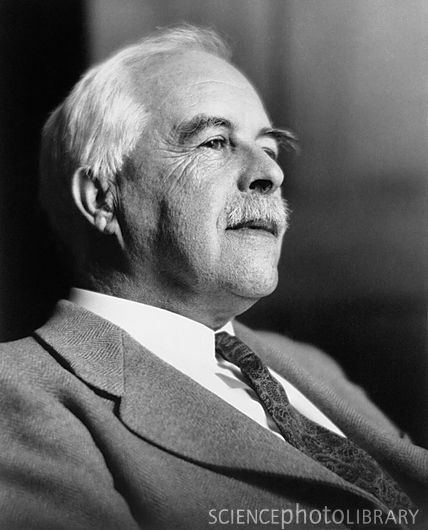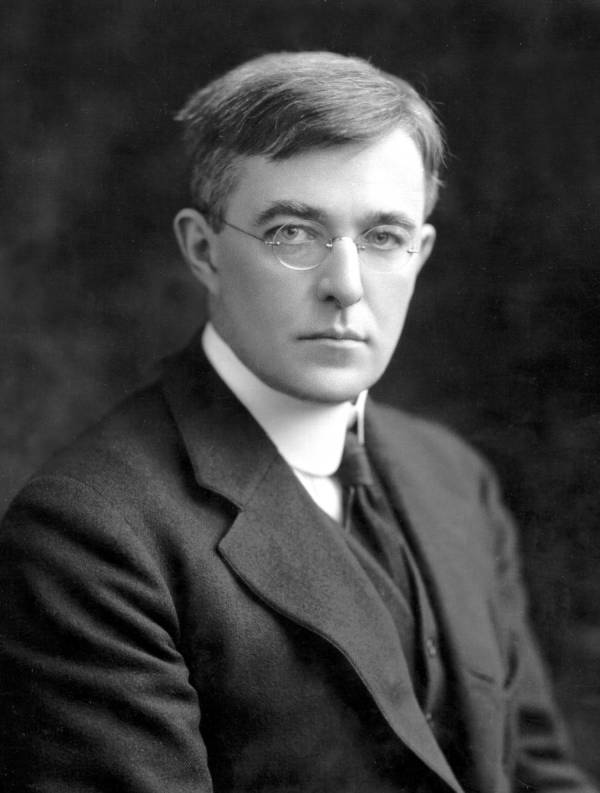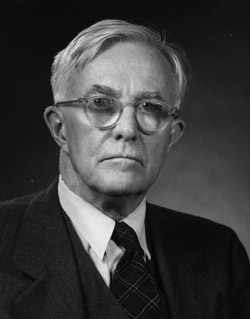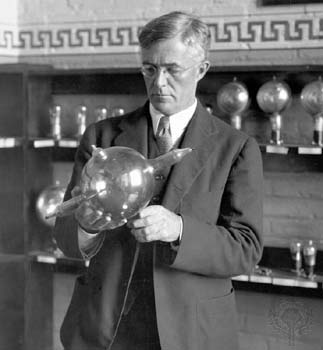<Back to Index>
- Chemist Gilbert Newton Lewis, 1875
- Chemist Irving Langmuir, 1881
PAGE SPONSOR


Gilbert Newton Lewis FRS (October 23, 1875 – March 23, 1946) was an American physical chemist known for the discovery of the covalent bond (Lewis dot structures and 1916 paper "The Atom and the Molecule"), his purification of heavy water, his reformulation of chemical thermodynamics in a mathematically rigorous manner accessible to ordinary chemists, his theory of Lewis acids and bases, and his photochemical experiments. In 1926, Lewis coined the term "photon" for the smallest unit of radiant energy. He was a brother in Alpha Chi Sigma, the professional chemistry fraternity, and for most of his long professorial career, a professor of chemistry at the University of California, Berkeley.
Lewis was born and raised in Weymouth, Massachusetts, where there exists a street named for him, G.N. Lewis Way, off of Summer Street. Additionally, the wing of the new Weymouth High School Chemistry department has been named in his honor. After earning his Ph.D. at Harvard under the direction of Theodore Richards, Lewis stayed as an instructor for a year before taking a traveling fellowship, studying under the physical chemists Wilhelm Ostwald at Leipzig and physicist Walther Nernst at Göttingen. While working in Nernst's lab, Nernst and Lewis apparently developed a lifelong enmity. A friend of Nernst's, Wilhelm Palmær, was a member of the Nobel Chemistry Committee. There is evidence that he used the Nobel nominating and reporting procedures to block a Nobel Prize for Lewis in thermodynamics by nominating Lewis for the prize three times, and then using his position as a committee member to write negative reports.
After his stay in Nernst's lab, Lewis returned to Harvard as an
instructor for three more years, and in 1904 left to become
Superintendent of Weights and Measures for the Bureau of Science of the Philippine Islands in Manila. The next year he returned to Cambridge, Massachusetts when the Massachusetts Institute of Technology
(MIT) appointed him to a faculty position, in which he had a chance to
join a group of outstanding physical chemists under the direction of Arthur Amos Noyes.
He became an assistant professor in 1907, associate professor on 1908,
and full professor in 1911. He left MIT in 1912 to become a professor of
physical chemistry and dean of the College of Chemistry at the University of California, Berkeley. Lewis Hall at Berkeley, built in 1948, is named in his honor.
About 1902 Lewis started to use unpublished drawings of cubical atoms in his lecture notes, in which the corners of the cube represented possible electron positions. Lewis later cited these notes in his classic 1916 paper on chemical bonding, as being the first expression of his ideas.
In 1908 he published the first of several papers on relativity, in which he derived the mass - energy relationship in a different way from Albert Einstein's derivation. In 1909, he and Richard Tolman combined his methods with special relativity. In 1912 Lewis and Edwin Bidwell Wilson presented a major work in mathematical physics that not only applied synthetic geometry to the study of spacetime, but also noted the identity of a spacetime squeeze mapping and a Lorentz transformation.
Lewis also introduced the thermodynamic concept of activity and coined the term "fugacity".
On June 21, 1912, he married Mary Hinckley Sheldon, daughter of a Harvard professor of Romance languages. They had two sons, both of whom became chemistry professors, and a daughter.
In 1913, he was elected to the National Academy of Sciences. He resigned in 1934, refusing to state the cause for his resignation; it has been speculated that it was due to a dispute over the internal politics of that institution or to the failure of those he had nominated to be elected. His decision to resign may have been sparked by resentment over the award of the 1934 Nobel Prize for chemistry to his student, Harold Urey, for the discovery of deuterium, a prize Lewis almost certainly felt he should have shared for his work on purification and characterization of heavy water.
In 1916, he published his classic paper on chemical bonding "The Atom and the Molecule" in which he formulated the idea of what would become known as the covalent bond, consisting of a shared pair of electrons, and he defined the term odd molecule (the modern term is free radical) when an electron is not shared. He included what became known as Lewis dot structures as well as the cubical atom model. These ideas on chemical bonding were expanded upon by Irving Langmuir and became the inspiration for the studies on the nature of the chemical bond by Linus Pauling.
In 1919, by studying the magnetic properties of solutions of oxygen in liquid nitrogen, he found that O4 molecules were formed. This was the first evidence for tetratomic oxygen.
In 1921, Lewis was the first to propose an empirical equation describing the failure of strong electrolytes to obey the law of mass action, a problem that had perplexed physical chemists for twenty years. His empirical equations for what he called ionic strength were later confirmed to be in accord with the Debye - Hückel equation for strong electrolytes, published in 1923.
In 1923, he formulated the electron - pair theory of acid - base reactions. In the so-called Lewis theory of acids and bases, a "Lewis acid" is an electron - pair acceptor and a "Lewis base" is an electron - pair donor. This year he also published a monograph on his theories of the chemical bond.
Based on work by J. Willard Gibbs, it was known that chemical reactions proceeded to an equilibrium determined by the free energy of the substances taking part. Lewis spent 25 years determining free energies of various substances. In 1923 he and Merle Randall published the results of this study, which helped formalize modern chemical thermodynamics.
In 1926, he coined the term "photon" for the smallest unit of radiant energy (light). Actually, the outcome of his letter to Nature was not what he had intended. In the letter, he proposed a photon being a structural element, not energy. He insisted on the need for a new variable, the number of photons. Although his theory differed from the quantum theory of light introduced by Albert Einstein in 1905, his name was adopted for what Einstein had called a light quantum (Lichtquant in German).
Lewis was the first to produce a pure sample of deuterium oxide (heavy water) in 1933 and the first to study survival and growth of life forms in heavy water. By accelerating deuterons (deuterium nuclei) in Ernest O. Lawrence's cyclotron, he was able to study many of the properties of atomic nuclei. During the 1930s, he was mentor to Glenn T. Seaborg, who was retained for post - doctoral work as Lewis' personal research assistant. Seaborg went on to win the 1951 Nobel Prize in Chemistry and have the element Seaborgium named in his honor while he was still alive.
Over the course of his career, Lewis published on many other subjects besides those mentioned in this entry, ranging from the nature of light quanta to the economics of price stabilization. In the last years of his life, Lewis and graduate student Michael Kasha, his last research associate, established that phosphorescence of organic molecules involves emission of light from one electron in an excited triplet state (a state in which two electrons have their spin vectors oriented in the same direction, but in different orbitals) and measured the magnetic nature of this triplet state, paramagnetism.
In 1946, a graduate student found Lewis's lifeless body under a laboratory workbench at Berkeley. Lewis had been working on an experiment with liquid hydrogen cyanide, and deadly fumes from a broken line had leaked into the laboratory. The coroner ruled that the cause of death was coronary artery disease, but some believe that it may have been a suicide. Berkeley Emeritus Professor William Jolly, who reported the various views on Lewis's death in his 1987 history of UC Berkeley’s College of Chemistry, From Retorts to Lasers, wrote that a higher-up in the department believed that Lewis had committed suicide.
If Lewis's death was indeed a suicide, a possible explanation was depression brought on by a lunch with Irving Langmuir.
Langmuir and Lewis had a long rivalry, dating back to Langmuir's
extensions of Lewis's theory of the chemical bond. Langmuir had been
awarded the 1932 Nobel Prize in chemistry for his work on surface chemistry,
while Lewis had not received the Prize despite having been nominated 35
times. On the day of Lewis's death, Langmuir and Lewis had met for
lunch at Berkeley, a meeting that Michael Kasha recalled only years
later.
Associates reported that Lewis came back from lunch in a dark mood,
played a morose game of bridge with some colleagues, then went back to
work in his lab. An hour later, he was found dead. Langmuir's papers at
the Library of Congress confirm that he had been on the Berkeley campus that day to receive an honorary degree.



Irving Langmuir (31 January 1881 – 16 August 1957) was an United States chemist and physicist. His most noted publication was the famous 1919 article "The Arrangement of Electrons in Atoms and Molecules" in which, building on Gilbert N. Lewis's cubical atom theory and Walther Kossel's chemical bonding theory, he outlined his "concentric theory of atomic structure". Langmuir became embroiled in a priority dispute with Lewis over this work; Langmuir's presentation skills were largely responsible for the popularization of the theory, although the credit for the theory itself belongs mostly to Lewis. While at General Electric, from 1909 – 1950, Langmuir advanced several basic fields of physics and chemistry, invented the gas filled incandescent lamp, the hydrogen welding technique, and was awarded the 1932 Nobel Prize in Chemistry for his work in surface chemistry. He was the first industrial chemist to become a Nobel laureate. The Langmuir Laboratory for Atmospheric Research near Socorro, New Mexico, was named in his honor as was the American Chemical Society journal for Surface Science, called Langmuir.
Irving Langmuir was born in Brooklyn, New York, on 31 January 1881. He was the third child of four of Charles Langmuir and Sadie, née Comings. During his childhood, Langmuir's parents encouraged him to carefully observe nature and to keep a detailed record of his various observations. When Irving was eleven, it was discovered that he had poor eyesight. When this problem was corrected, details that had previously eluded him were revealed, and his interest in the complications of nature was heightened.
During his childhood, Langmuir was influenced by his older brother, Arthur Langmuir. Arthur was a research chemist who encouraged Irving to be curious about nature and how things work. Arthur helped Irving set up his first chemistry lab in the corner of his bedroom, and he was content to answer the myriad of questions that Irving would pose. Langmuir's hobbies included mountaineering, skiing, piloting his own plane, and classical music. In addition to his professional interest in the politics of atomic energy, he was concerned about wilderness conservation.
Langmuir attended his early education at various schools and institutes
in America and Paris (1892 – 1895). Langmuir graduated high school from Chestnut Hill Academy
(1898), an elite private school located in the affluent Chestnut Hill
area in Philadelphia. He graduated with a Bachelor of Science degree in metallurgical engineering from the Columbia University School of Mines (the first mining and metallurgy school in the U.S., established,1864 and presently known as Fu Foundation School of Engineering and Applied Science) in 1903. He earned his Ph.D. degree in 1906 under Nobel laureate Walther Nernst in Göttingen, for research done using the "Nernst glower",
an electric lamp invented by Nernst. His doctoral thesis was entitled
“On the Partial Recombination of Dissolved Gases During Cooling.” He
later did postgraduate work in chemistry. Langmuir then taught at Stevens Institute of Technology in Hoboken, New Jersey, until 1909, when he began working at the General Electric research laboratory (Schenectady, New York).
His initial contributions to science came from his study of light bulbs (a continuation of his Ph.D. work). His first major development was the improvement of the diffusion pump, which ultimately led to the invention of the high - vacuum tube. A year later, he and colleague Lewi Tonks discovered that the lifetime of a tungsten filament was greatly lengthened by filling the bulb with an inert gas, such as argon. He also discovered that twisting the filament into a tight coil improved its efficiency. These were important developments in the history of the incandescent light bulb. His work in surface chemistry began at this point, when he discovered that molecular hydrogen introduced into a tungsten - filament bulb dissociated into atomic hydrogen and formed a layer one atom thick on the surface of the bulb.
His assistant in vacuum tube research was his cousin William Comings White.
In 1917, he published a paper on the chemistry of oil films
that later became the basis for the award of the 1932 Nobel Prize in
chemistry. Langmuir theorized that oils consisting of an aliphatic chain
with a hydrophilic end group (perhaps an alcohol or acid) were oriented
as a film one molecule thick upon the surface of water, with the
hydrophilic group down in the water and the hydrophobic chains clumped
together on the surface. The thickness of the film could be easily
determined from the known volume and area of the oil, which allowed
investigation of the molecular configuration before spectroscopic
techniques were available.
As he continued to study filaments in vacuum and different gas environments, he began to study the emission of charged particles from hot filaments (thermionic emission). He was one of the first scientists to work with plasmas and was the first to call these ionized gases by that name, because they reminded him of blood plasma. Langmuir and Tonks discovered electron density waves in plasmas that are now known as Langmuir waves.
He introduced the concept of electron temperature and in 1924 invented the diagnostic method for measuring both temperature and density with an electrostatic probe, now called a Langmuir probe
and commonly used in plasma physics. The current of a biased probe tip
is measured as a function of bias voltage to determine the local plasma
temperature and density. He also discovered atomic hydrogen, which he put to use by inventing the atomic hydrogen welding process; the first plasma weld ever made. Plasma welding has since been developed into gas tungsten arc welding.
Following World War I Langmuir contributed to atomic theory and the understanding of atomic structure by defining the modern concept of valence shells and isotopes.
Langmuir was president of the Institute of Radio Engineers in 1923.
He joined Katharine B. Blodgett to study thin films and surface adsorption. They introduced the concept of a monolayer (a layer of material one molecule thick) and the two - dimensional physics which describe such a surface. In 1932 he received the Nobel Prize in Chemistry "for his discoveries and investigations in surface chemistry." In 1938, Langmuir's scientific interests began to turn to atmospheric science and meteorology. One of his first ventures, although tangentially related, was a refutation of the claim of entomologist Charles H.T. Townsend that the deer botfly flew at speeds in excess of 800 miles per hour. Langmuir estimated the fly's true speed at 25 miles per hour.
After observing windrows of drifting seaweed in the Sargasso Sea he discovered a wind driven surface circulation in the sea. It is now called the Langmuir circulation.
During World War II, Langmuir worked on improving naval sonar for submarine detection, and later to develop protective smoke screens and methods for deicing aircraft wings. This research led him to theorize that the introduction of dry ice and iodide into a sufficiently moist cloud of low temperature could induce precipitation (cloud seeding); though in frequent practice, particularly in Australia and the People's Republic of China, the efficiency of this technique remains controversial today.
In 1953 Langmuir coined the term "pathological science", describing research conducted with accordance to the scientific method, but tainted by unconscious bias or subjective effects. This is in contrast to pseudoscience, which has no pretense of following the scientific method. In his original speech, he presented ESP and flying saucers as examples of pathological science; since then, the label has been applied to polywater and cold fusion.
His house in Schenectady, was designated a National Historic Landmark in 1976.
Langmuir was married to Marion Mersereau in 1912 with whom he adopted two children: Kenneth and Barbara. After a short illness, he died in Woods Hole, Massachusetts, from a heart attack in 1957. His obituary ran on the front page of The New York Times.
According to author Kurt Vonnegut, Langmuir was the inspiration for his fictional scientist Dr. Felix Hoenikker in the novel Cat's Cradle. The character's invention of ice-nine eventually destroyed the world. Langmuir had worked with Vonnegut's brother, Bernard Vonnegut.